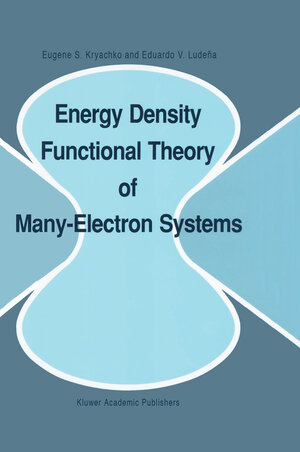
×
![Buchcover ISBN 9789401073813]()
Energy Density Functional Theory of Many-Electron Systems
von Eugene S. Kryachko und Eduardo V. LudeñaInhaltsverzeichnis
- 1. Energy density functional theory: historical and bibliographic sketch.
- 1.1. The Thomas-Fermi theory and its sequels.
- 1.2. One-electron equations.
- 1.3. Bibliographic sketch Monographies and books.
- 2. Many-electron wavefunctions, density matrices, reduced density matrices and variational principles.
- 2.1. Pure states and emsembles in quantum mechanics.
- 2.2. Reduced density matrices.
- 2.3. Spin structure of wavefunctions and reduced density matrices.
- 2.4. Variational principle in the Schrödinger picture of quantum chemistry.
- 3. The one-electron density.
- 3.1. The meaning of the one-electron density.
- 3.2. The one-electron density and molecular structure.
- 3.3. Charge distributions and atomic charges.
- 3.4. Quantum mechanics of an atomic fragment.
- 3.5. Molecular structure and its relation to topologic properties of one-electron densities.
- 3.5. b. Catastrophe points and their relation to the change in molecular structure.
- 4. An Introduction to density functional theory from the perspective of the independent-particle model and its corrections.
- 4.0. Preamble.
- 4.1. The Hartree-Fock variational approach.
- 4.2. The exact level.
- 4.3. The kinetic energy term.
- 4.4. The N-representability problem for D2 and ?.
- 5. The Thomas-Fermi energy density functional and its generalization.
- 5.1. Formulation of the Thomas-Fermi model for atoms and ions.
- 5.2. Leading quantum corrections to the Thomas-Fermi atom.
- 5.3. Post Thomas-Fermi-Dirac-von Weizsaker developments in density functional theory.
- 5.4. Molecular structure and molecular interactions from the perspective of the Thomas- Fermi theory and its extensions.
- 6. Foundations of density functional theory.
- 6.0. Preamble.
- 6.1. Correspondence between ground-state one-electron densities and external potentials.
- 6.2. v-representability of one-electron densities.
- 6.3 N-representability of one-electron densities.
- Problems.
- 6.4. The second Hohenberg-Kohn theorem.
- 6.5. Universal functionals for non-v-representable one-electron densities.
- 6.6. Approximate method for the determination of universal functional.
- 6.7. A universal functional of the reduced first-order density operator.
- 7. A rigorous formulation of the variational principle in density functional theory.
- 7.1. Introductory remarks.
- 7.2. Explicit construction of the energy density functional.
- 7.3 Reformulation of the Hohenberg-Kohn theorems.
- 7.4. The spin-density functional formalism.
- 7.5. Density functional theory for excited states.
- 7.6 The non-adiabatic energy density functional theory.
- 7.7. The concept of fractional occupation numbers in density functional theory.
- 7.8. N-representability of experimentally determined densities.
- 7.9. The inverse problem in density functional theory.
- 8. The self-consistent field concept in density functional theory.
- 8.1. Introductory comments.
- 8.2. The Slater-Kohn-Sham ansatz. Self-consistent field version of exchange-only density functional theory.
- 8.3. The inverse problem in the Slater-Kohn-Sham ansatz.
- 8.4 The Kohn-Sham ansatz.
- 9. Synopsis and future trends.
- 9.1 Density functional theory: overview and interfaces.
- Theory of nuclear structure.
- 9.2 Concluding remarks.




